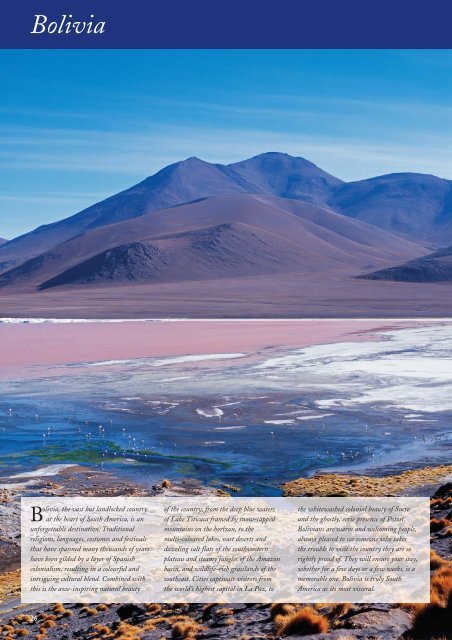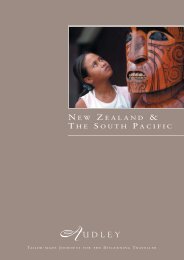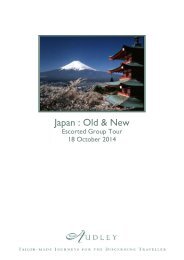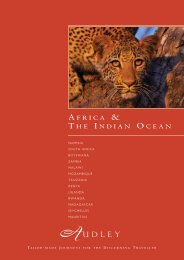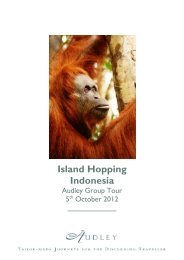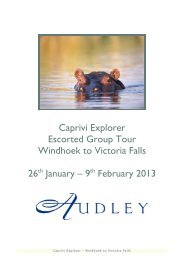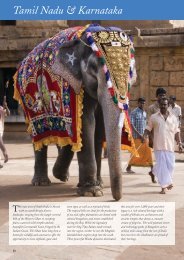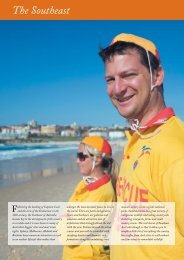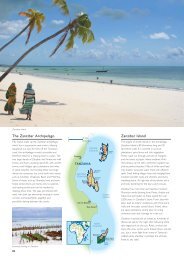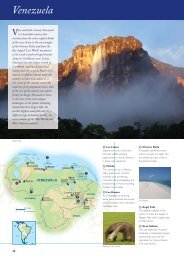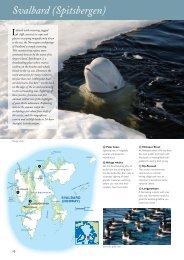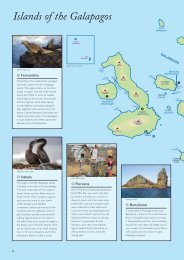Bolivia - Audley Travel
Bolivia - Audley Travel
Bolivia - Audley Travel
- No tags were found...
You also want an ePaper? Increase the reach of your titles
YUMPU automatically turns print PDFs into web optimized ePapers that Google loves.
Green Lagoon, southwest <strong>Bolivia</strong>The Southern AltiplanoFar off the beaten track, this stark and surreallandscape makes for a bumpy, windy yetcompletely captivating few days. The adventurebegins on the track to the sequestered town ofUyuni with its outlying ‘train cemetery’, where theskeletons of steam locomotives rust in the sun.A blinding sheet of salt awaits you at the Salar deUyuni, the world’s largest salt lake, where you arein a simple world of blue and white, or evenmore bizarrely where seasonal waters can reflectthe sky and dissolve the horizon. Sip coca teasitting on an island in the sea of salt that iscovered in giant cacti, take a dip in a naturalthermal pool overlooked by volcanoes, enjoy athree course meal on a picnic table watched byllamas and alpacas. Continuing south, strange rockformations rise up from the desert, mud geysersbubble and wisps of smoke curl out of sleepingvolcanoes. Flamingos strut around lakes of unusualbut beautiful hues of red, blue, green and white.Salar de Uyuni30Church, ConcepciónSanta Cruz and theJesuit MissionsFar from the Andean peaks lies the busy andhumid city of Santa Cruz, where you can seesloths hanging in the palm-filled main plaza andcrowds worshipping in a huge church made ofbamboo. Heading northeast by road, flatfarmlands merge into rolling hills and ranches asyou reach the colonnaded streets of the sleepyJesuit towns, such as Concepción. The finereligious craftsmanship of the beautiful churcheshere is a key part of <strong>Bolivia</strong>’s heritage. If you havea keen interest in wildlife, your road journey inthese lowlands of <strong>Bolivia</strong> could also take you toAmboró National Park for a couple of days.Thanks to its three distinct eco-systems thatencompass the Amazon River basin, the Andeanfoothills and the Chaco plain, this is an area ofgreat bio-diversity and is thought to be home tomore species of life per hectare than anywhereelse on earth.Ecological Areas<strong>Bolivia</strong> has many other virtually undiscoveredareas for the visitor interested in the naturalworld. Visits to these places are not simple orcheap, but the wealth of bio-diversity makes foran astounding experience.The town of Rurrenabaque, in the northwestof <strong>Bolivia</strong>, is the starting point for trips into theAmazonian area of Pilón Lajas EcologicalReserve or the vast Madidi National Park thatencompasses cloud and rainforest. Both haveexcellent lodges (Mapajo in Pilón Lajas andChalalán Ecolodge in Madidi) with indigenousguides to explore and search for some of thelocal animal populations including monkeys,caiman, turtles and macaws. The dry season ofJune to October is the best time to go.Noel Kempff Mercado National Park, in the fareast of <strong>Bolivia</strong>, is another unique habitat thatencompasses rainforest and savannah and over620 bird species have been recorded hereincluding 20 species of parrot. Its remotenessmeans it receives few visitors and, as with any ofthe places mentioned in this section, the trip isan exercise in dedication – but it is worth it forthe sights that await.
Suggested itinerariesTailoring your tripThe itinerary shown is designed to give you aflavour of what is possible, and is a route thatworks particularly well. We can use this as a basisto plan your trip or can design a completelydifferent itinerary to suit your tastes and interests.Please call one of our <strong>Bolivia</strong> specialists to startplanning your itinerary.Telephone: 01993 838 645Getting around<strong>Bolivia</strong> is a big country, but we do not useinternal flights often as the main attractions donot have airports nearby. Therefore most of thejourneys are done by road, some tarmaced butmany bumpy, in minibuses or 4x4 vehicles,accompanied by a guide and experienced driver.We are acutely aware that travelling extensivelythrough <strong>Bolivia</strong> can be a little arduous due to thedistances involved, the altitude and the possibledelays, but we firmly believe that it is more thanworth it, as long as you are prepared for it.As well as a stand-alone destination in its ownright, <strong>Bolivia</strong> fits in perfectly with itineraries toPeru or Chile (or both), and we have researcheda number of overland routes to combine thesethree countries.When to goJan Feb Mar Apr May Jun Jul Aug Sep Oct Nov Dec~ ~ ~ ✓ ✓✓ ✓✓ ✓✓ ✓✓ ✓✓ ✓ ~ ~✓✓ The best time to travel.✓ A good time to travel, but there may be some factors to be aware of.~ <strong>Travel</strong> is possible, but this is not the best time of year.✕ <strong>Travel</strong> is not recommended.The best time to visit the highland areas isbetween April and October, this is the coolerwinter period but it should be dry. In thesouthern altiplano the sky will be blue but it willbe very cold, dropping to many degrees belowfreezing at night. The summer rainy season fromNovember to March can cause transportproblems in the highlands, while the easternlowlands are warm and steamy year-round.Time difference: GMT-4 hoursFlight time from UK: 18 hoursPricesWe offer trips to cater for a wide range ofbudgets. You can find up-to-date guidelineprices for your trip to <strong>Bolivia</strong> on our website,alternatively please call our specialists todiscuss your plans.Classic <strong>Bolivia</strong>A stunning adventure to the heart of the country,this tour explores the incredible places along<strong>Bolivia</strong>’s Andean spine. From the blue waters ofLake Titicaca to the colonial towns of Sucre andPotosí to the stunning, desolate landscapes of thesouth. This trip is for those with an adventurousspirit and a hankering to get off the beaten track.Day 1Day 2Day 3Day 4Day 5Day 6Day 7Day 8Day 9Day 10Day 11Fly from the UK to La Paz.Arrive in La Paz, rest in order tostart acclimatising.Explore the fascinating streets,museums and markets of the city.Afternoon visit to theTiahuanaco ruins.Drive to Lake Titicaca, visit theUros-Uruitos Indians on their floatingislands, continuing to Sun Island.Re-trace your steps back to La Paz.Fly to Sucre, afternoon explorationof this delightful colonial city.<strong>Travel</strong> by road to Potosí, take a tourof the silver mine and the colonialstreets of the city.Continue your road journey toUyuni, visit the train cemetery.Head across the vast Salar de Uyuni,visit the salt mining settlement ofColchani and the unusual Fish Islandthat is covered with giant cacti.Continue south past lakes ofvarying different hues towards theRed Lagoon.Visit the Sol de Manaña geysers, seethe stone tree and walk around theGreen Lagoon.Day 12Continue south, crossing the borderinto Chile and on into the oasis townof San Pedro de Atacama.Days 13-14 Excursions in the Atacama Desert.Day 15Day 16LakeTiticacaRedLagoonStay longerLa PazUyuniSucrePotosíGreenLagoonFly to Santiago to connect with yourinternational flight.Arrive in the UK.Green LagoonSan Pedrode AtacamaCHILESantiagoStay longer on Sun Island to explore more ofthe island and walk to the Chincana ruins. FromLa Paz travel down to the steamy town ofCoroico, either by car or mountain bike.Alternatively, fly north from La Paz toRurrenebaque and into the Amazon at ChalalánLodge. More time in Sucre would allow time tovisit the colourful indigenous market town ofTarabuco. A different and far lesser travelled routefrom <strong>Bolivia</strong> into Chile is across the stunningSajama National Park, with barren landcapes,grazing vicuña and snow-capped volcanoes.Sunset over Salar de Uyuniwww.audleytravel.com/bolivia ● 01993 838 645 ● <strong>Bolivia</strong> 31


